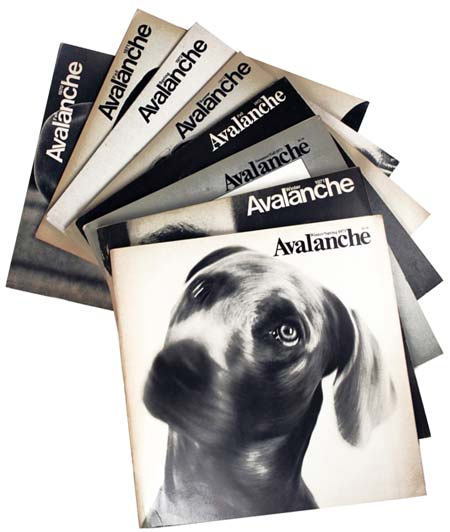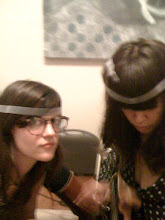Thursday, June 23, 2011
Thursday, June 2, 2011
Tuesday, May 10, 2011
Artists Space launches new venue: Artists Space: Books & Talks' on Grand St. and West Broadway

May 10, 2011, 7 - 9 pm at Artists Space
38 Greene St, 3rd Floor
Artists Space: Books & Talks is an additional 2,500 square foot storefront venue on Grand Street and West Broadway. This space will in future host a bookshop – with 1,000 titles exclusively selected by 100 artists, writers and critics, each suggesting 10 antiquarian or new titles – and an auditorium, allowing Artists Space to more frequently host talks, screenings and other events.
This new venture will compliment Artists Space: Exhibitions, the original 7,500 square foot exhibition space on Greene and Grand Streets, located within two minutes walking distance from Artists Space: Books & Talks.
As a pre-opening event, Artists Space: Books & Talks will host the launch of dOCUMENTA (13)´s 100 Notizen – 100 Gedanken / 100 Notes – 100 Thoughts series. The first 17 notebooks will be discussed at Artists Space with some of the New York-based authors including: Susan Buck-Morss, Kenneth Goldsmith, Paul Ryan, and Michael Taussig. The evening will be moderated by Bettina Funcke, Head of Publications for dOCUMENTA (13) and Chus Martínez, Head of Department, Member of Core Agent Group. Carolyn Christov-Bakargiev, Artistic Director of dOCUMENTA (13), will take part in the discussion.
As a prelude to the 2012 exhibition, dOCUMENTA (13) has initiated a series of publications driven by the logic of the mind-at-work, presenting, writing, and drawing scenarios that point outside the normative bounds of academic text production. In the form of facsimiles of existing notebooks, commissioned essays, collaborations between artists and writers, and conversations, they present models of connection-making between the private and the public, between the pre-stage of intuitions, the naming of ideas and the key-chain of arguments that provide the reader with a singular insight into working methods. The series is formed through interconnections, so that the notebooks could be described as an "interregnum," a temporary rupture in discursive intelligence; they do not direct us towards reason as such, but towards a different understanding of the role of consciousness. It is pure speculation: can one effectively transform thinking while thinking at the same time? The notebooks show us the hand trying to trace other logics, trying to travel a bit farther away from the already known in order to cover a distance between the now and the near future.
The notebooks appear in three different formats (A6, A5, B5) and range from 16 to 48 pages in length. Contributors hail from diverse fields – art, science, philosophy, psychology, anthropology, political theory, literature studies, and poetry – and include Etel Adnan, Kenneth Goldsmith, Péter György, Emily Jacir, Susan Buck-Morss, Alejandro Jodorowsky, Carolyn Christov-Bakargiev, William Kentridge, Peter L. Galison, Erkki Kurenniemi, Lars Bang Larsen, György Lukács, Christoph Menke, Paul Ryan, Ayreen Anastas, Rene Gabri, Vandana Shiva, G.M. Tamás, Michael Taussig, Jalal Toufic, Ian Wallace, and Lawrence Weiner.
Commissioned by dOCUMENTA (13)'s Artistic Director Carolyn Christov-Bakargiev together with Chus Martínez, Head of Department, Member of Core Agent Group. This series is edited by Bettina Funcke, Head of Publications.
The 100 Notizen – 100 Gedanken / 100 Notes – 100 Thoughts will be launched at various places and in various moments, each accompanied by a discussion on the nature and the aim of this publishing project.
You can buy individual notebooks or subscribe to the entire series of 100 notebooks at www.hatjecantz.de/documenta13. For further information about dOCUMENTA (13), including the publications, visit www.documenta.de
Forthcoming at Artists Space
Site
Video Data Bank launches new website

Video Data Bank has launched a new website. Hiring web developers Fuse IQ for the re-design, the new site is now much more user friendly and has a variety of fun and functional new features. It's exciting that the nearly 40 year old 'institution/collection' will now be more accessible and transparent to the public.
Video Data Bank's site has had the same design as long as I have been using it, which amounts to something like 5 years. Like most websites, it had room for improvement. Specifically, the small images and deeply nested resources on the the previous site. Also, (I might be imagining this) but I'm pretty sure the last site had a black interface, which looked and felt bulky when coupled with the small type and thumbnail images. The white is much cleaner, and the information is much better organized in general, which leads to easier navigation. The main things that have changed include the Video Art Gallery, which features larger images and longer clips; user accounts, improved searching, a news and events section, and resources. Also, curators and programmers can now preview videos with special permission through their user account.
It's interesting how a redesign of a website can really change it's public appearance and functionality. It will now be much more user-friendly, which will hopefully lead to more video sales/rentals from collectors, collections, and institutions. Also, better-accessible archives and resources will enable future scholarship.
Judging by the design of the site, this was not a cheap upgrade. Congrats to VDB for finding a way to finance this project, which will only further the success, access, and visibility of the collection. In a moment, where institutions' web presence is nearly as essential for generating public awareness as their reputation, this upgrade comes as a great step forward!
Below is a list of new features from the site, which can also be viewed by following this link:
Whats New?
The staff team at Video Data Bank is pleased and proud to announce the launch of our new and improved website, redesigned with a fresh look and a more user-friendly experience. With the help of our developers at Fuse IQ, we've been able to improve navigation, enable online ordering, and bring our clients and artists a number of great new features, such as:
User Accounts: Create a new Account so you can login to vdb.org at any time - make comments about your favorite videos, create video wish lists, donate to VDB, or order online.
Wish Lists: Wish lists will make it easy for you to keep track of your most-wanted videos. After creating your user account, just click "Add to Wish List", choose your format & use type, and add to your wish list. Send your wish list on to others - great for faculty who need to communicate with their librarians and purchasing departments.
Online Ordering: When logged in to your user account, use vdb.org to process standard sales and rentals for most titles. Just click "Order Video", choose your format & use type, and add to your shopping cart. Check out using an institutional purchase order, or pay via credit card with our secure hosted payment gateway.
Video Art Gallery: View the latest and greatest of VDB clips in the Video Art Gallery. Select from New Releases, Featured Videos, Most Viewed, and Random Picks.
Improved Browsing and Searching the Collection: Navigating the collection is now very simple! In the Browse the Collection side bar, you can search by Artist or Title, check out the latest additions to the archive in New Releases and DVD Box Sets, scan through our Curated and Single Artist Compilations, or navigate one of our Special Collections: On Art and Artists, Videofreex Archive, Early Video Art, Kuchar Archive.
Bigger and Better Video Clips and Images: Tiny clips are a thing of the past! View full-screen, high-quality clips and images for all VDB titles in distribution throughout the new site.
Listing Style: Throughout the site, choose to view information via one of two different styles - Gallery View or List View.
Up-to-the-Minute News + Events: It's easier than ever for us to feature VDB artist news, upcoming events, recent newsletters, and VDB in the press.
Video Art Related Merchandise: Show your love for VDB! Order a copy of the essential Feedback: The Video Data Bank Catalog of Video Art and Artist Interviews, or purchase some new VDB swag (more coming soon!).
Video Art Resources: Download essays about video art and artists commissioned by VDB, scan our comprehensive, annotated bibliography of critical writing on the history of video and media art, view links to other organizations and resources related to VDB, or check out what's available in our on-site print library.
Online Donations: As a 501(c)3 not-for-profit organization, VDB relies on funding from federal and state agencies, and donations from the public. Here you can quickly and easily donate to invest in the continued success of VDB's mission and programs. All donations are tax-deductible.
Curators and programmers will also have the ability to view full-length video previews, and our artists can update their contact information and check in anytime to see where their work has been previewed, screened or sold.
Note that the new vdb.org is still in the "soft launch" phase, and you may encounter minor bugs or missing information while using the site. We appreciate your patience during this time, and ask that you notify us with any problems you come across by emailing info@vdb.org. Thank you!
Thursday, May 5, 2011
Ken Jacobs Interview in TimeOut Chicago
The avant-garde icon will present a live work at the Film Studies Center.
LIGHT MOTIF Jacobs, inset, performs at the Paris Cinematheque. “The Green Wave,” background, is a DV experiment in stereoscopic imagery “without spectacles.”
For more than 50 years, Ken Jacobs has been a key figure in American experimental cinema, creating a steady stream of acclaimed and influential films, live moving-image works and, more recently, digital videos. He is best known for his seminal Tom, Tom, the Piper’s Son (1969), which expands a 1905 film into a feature-length exploration of its form and images, and the decades-in-the-making, seven-hour epic Star Spangled to Death (2003). But even those familiar with Jacobs’s filmmaking might be astonished at the sheer number of live works he’s done over the years, including shadow plays, his amazing Nervous System setup (in which two projectors and a rotating shutter allow for near-forensic investigations of film material) and the Nervous Magic Lantern, a simpler but no less amazing device that hearkens back to 19th-century technology. The NYC-based filmmaker, 77, will perform a work with the latter on Thursday 5. We e-mailed him about
his first appearance in Chicago in three decades.
You’ve been doing live-projection works almost as long as you’ve been making films. What first interested you in these more ephemeral kinds of “cinema”? How and why did you start?
With my first money for a film projector, in 1954, I bought a Kodak Film Analyst for examining 16mm film at various speeds—going backwards and forwards. Occasionally, friends would sit in on these studies, which I never thought about as performance.… In 1975, teaching in Binghamton [New York], I mentioned an idea to a fellow artist-teacher, Dan Barnett: using both of the department’s stop-motion projectors to hold sequential frames on screen from two prints of a film, polarized, and viewing them with polaroid spectacles.… Dan was enthusiastic and we tried it. And it was a dream come true. The scene suddenly appeared in deep space. Space was a turn-on for me. This led to my first public film performance, The Impossible: Chapter One, South’wark Fair.
The Nervous Magic Lantern and Nervous System performances seem to come from the same interests that led to Tom, Tom, the Piper’s Son: a fascination with early cinema, exploring the material of film and transforming and abstracting reality, but heightened by the possibility of creating 3-D. Do you see them as related?
My interest in [the 1905] “Tom, Tom” came about because it seemed such a disaster; the primitive film-making was showing all over it. It showed its age. Now and again I saw a character look into the camera, looking at me 60 years later. The role fell away and here was a human. I was touched by this and that got me into chasing down the reality of what is this strange ribbon of images called film. Four of the five chapters of The Impossible utilized and further investigated scenes from “Tom, Tom.” I would be coming up with different techniques but the impulse to create crazy 3-D events was consistent.
Can you describe a bit what the Nervous Magic Lantern is and what audiences can expect?
The Nervous Magic Lantern has got to be the strangest thing I ever attempted. It came to me in a dream, and made no sense. No projector has ever been more basic: a light, a lens, a shutter and some space between light and lens for me to fool around. Images are vastly 3-D and going through impossible changes. I’m enjoying it with audiences as long as I can before it’s declared illegal.
Jacobs and his wife, Flo, will present one of his Nervous Magic Lantern works, Time Squared, along with two digital videos, at the Film Studies Center at the University of Chicago Thursday 5 at 7pm.
Tuesday, May 3, 2011
Mark Fisher to lecture at Cooper Union
From Fisher's website:
What are grey vampires and how do they retard the insurrectionary potential of digital discourse? How does Derrida’s notion of hauntology contribute to an understanding of dubstep artist Burial? Is ‘Basic Instinct 2’, routinely derided as a cine-atrocity, a Lacanian reworking of Ballard, Baudrillard and Bataille in service of the creation of a “phantasmatic, cybergothic London”? What is interpassivity and in what ways has it come to define the corporatized incarceration of modern academia?
Over the last decade, Mark Fisher has established a reputation as one of the exhilarating cultural theorists in Britain. A co-founder of the Cybernetic Culture Research Unit (CCRU) at Warwick University – and described by Simon Reynolds as the academic equivalent of Apocalypse Now’s Colonel Kurtz – he brings together psychoanalysis, political analysis and speculative fiction to create an extraordinary body of rogue scholarship, a theory-rush with few parallels.
Fisher is the author of ‘Capitalist Realism’, the editor of ‘The Resistible Demise of Michael Jackson’ (both Zer0, 2009), and writes regularly for Sight and Sound, Film Quarterly, The Wire and Frieze, as well as maintaining a well-known blog at k-punk.abstractdynamics.org. He teaches at the University of East London, Goldsmiths, University of London, and the City Literary Institute.
The Colloquium for Unpopular Culture and NYU’s Asian/ Pacific/ American Studies program are pleased to be hosting Fisher’s first talks in America.
http://pontone.pl/pontones-special-guest-mix-k-punk-the-metaphysics-of-crackle/
--
MARK FISHER, THERE ARE NON-TIMES AS WELL AS NON-PLACES: REFLECTIONS ON HAUNTOLOGY
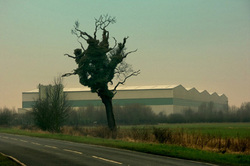 | 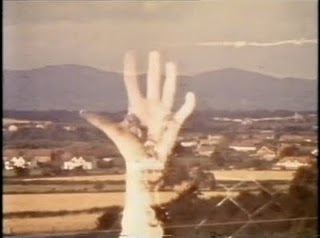 |
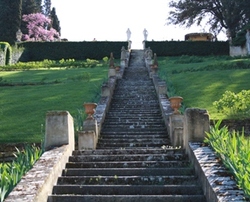 | 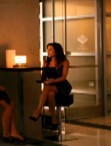 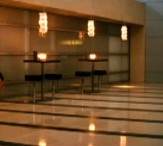 |
WHEN: Wednesday 4 May 2011, 6:30pm
WHERE: Room 471, 20 Cooper Square [East 5th and Bowery]
FREE AND OPEN TO THE PUBLIC
“Through their generic and transient qualities – workstations devoid of personal effects, relations with colleagues as fleeting as those with passengers on a commuter journey – many workplaces now resemble non-places, either literally, as in the case of a hotel, corporate coffee chain or out-of-town supermarket, or symbolically, in the form of temporary assignments for faceless employers (dis)located in anonymous buildings, where the worker-commuter then follows the same global timetables, navigates the same software applications and experiences the same sense of placelessness, the feeling of being mere data in the mainframe.”
So writes Ivor Southwood in his analysis of precarious labour, ‘Non-Stop Inertia’ (2011). In the last decade, the proliferation of corporate non-places has been accompanied by the spread of cyberspace-time, or Itime, a distributed or unpunctuated temporality. It’s no coincidence that, as this unmarked time increasingly came to dominate cultural and psychic space, Derrida’s concept hauntology (re)emerged as the name for a paradoxical zeitgeist. In ‘Specters of Marx’, Derrida argued that the hauntological was characterised by “a time out of joint”, and this broken time has been expressed in cultural objects that return to a wounded or distorted version of the past in flight from a waning sense of the present. Sometimes accused of nostalgia, the most powerful examples of hauntological culture actually show that nostalgia is no longer possible. In conditions where pastiche has become normalised, the question has to be: nostalgia compared to what?
James Bridle has recently argued that “the opposite of hauntology ... [is] to demand the radically new”, but hauntology in fact operates as a kind of thwarted preservation of such demands in conditions where - for the moment at least - they cannot be met. Whereas cyberspace-time tends towards the generation of cultural moments that are as interchangeable as transnational franchise outlets, hauntology involves the staining of particular places with time - albeit a time that is out of joint. In this lecture, Fisher will explore the hauntological culture of the last few years in relation to the question of place, using examples from music (Burial, The Caretaker, Ekoplekz, Richard Skelton), film (Chris Petit, Patrick Keiller) and fiction (Alan Garner, David Peace).
--
MARK FISHER, DEPACIFICATION PROGRAM: FROM CAPITALIST REALISM TO POST-CAPITALISM
WHEN: Thursday 5 May 2011, 6:30pm
WHERE: Room 471, 20 Cooper Square [East 5th and Bowery]
FREE AND OPEN TO THE PUBLIC
“It would be best, perhaps, to think of an alternate world - better to say the alternate world, our alternate world - as one contiguous with ours but without any connections or access to it. Then, from time to time, like a diseased eyeball in which disturbing flashes of light are perceived or like those baroque sunbursts in which rays from another world suddenly break into this one, we are reminded that Utopia exists and that other systems, other spaces, are still possible.” (Fredric Jameson, ‘Valences of the Dialectic’)
In his 2009 book ‘Capitalist Realism’, Mark Fisher started to explore some of the affective, psychological and political consequences of the deeply entrenched belief that there is no alternative to capitalism. After 1989, capital seemed to enjoy full spectrum dominance of both global space and the unconscious. Every imaginable future was capitalist. What has been mistaken for post-political apathy, Fisher argued, was a pervasive sense of reflexive impotence in the face of a neoliberal ideological program which sought to subordinate all of culture to the imperatives of business. The subject of post-Fordist capitalism is no passive dupe; this subject actively participates in an ‘interpassive’ corporate culture which solicits our involvement and encourages us to ‘join the debate’. As Fisher argues in the book, education has been at the forefront of this process, with teachers and lecturers locked into managerialist self-surveillance, and students induced into the role of consumers.
In the eighteen months since ‘Capitalist Realism’ was published, the neoliberal program has been seriously compromised, but capitalist realism has intensified - with austerity programs pushed through on the basis that it is unthinkable that capitalism should be allowed to fail. At the same time, this new, more desperate form of capitalist realism has also faced unexpected challenges from a militancy growing in Europe, the Middle East and even in the heartlands of neoliberalism such as the UK and the US. Now that history has started up again, and Jameson’s “baroque sunbursts” flare brighter than they have for a generation, we can begin to pose questions that had receded into the unimaginable during the high pomp of neoliberal triumphalism: what might a post-capitalism look like, and how can we get there?
Fisher will argue that the Left will only succeed if it can reclaim modernity from a neoliberal Right that has lost control of it. This entails understanding how the current possibilites for agency are contoured and constrained by the machinery of what Deleuze and Foucault called the Control Society, including cyberspace, the media landscape, psychic pathologies and pharmacology - failures to act are not failures of will, and all the will in the world will not eliminate capitalism. It also entails recognising that neoliberalism’s global hegemony arose from capturing desires which it could not satisfy. A genuinely new Left must be shaped by those desires, and not be lulled, once again, by the logics of failed revolts.
Monday, May 2, 2011
Rudy Wurlitzer retrospective at Anthology
I Went to Anthology on Saturday for the Wurlitzer retrospective, where the film Glen and Randa was followed by a Q&A between long-time friends and contemporaries, Robert Downy Sr. and the honored screenwriter himself, Rudy Wurlitzer.
The Q&A started with Downey thanking Anthology for finally doing an interesting retrospective, one that he would actually want to attend. Which I suppose was a compliment. Although I think it was also his attempt being humble, seeing as his own films are featured at the canonizing institution with high frequency.
Interesting anecdotes included stories about Hal Ashby, and how easy and inclusive of a director he was, how crazy and brilliant Sam Peckinpah was. (There was a story about Wurlitzer bringing Bob Dylan to Peckinpah's hacienda in Mexico introduce the two before 'Pat Garrett and Billy the Kid.' With each step the two took towards the hacienda, sounds of broken glass and gunshots were heard, and followed shortly by maids fleeing. When the two finally entered the director's bed-quarters, he was standing in front of the mirror naked, pointing a gun at his 'image.' Wurlitzer said that Bob Dylan knew he liked him because he thought Peckinpah was the real deal.)
Another story was about how Antonioni refused to work with Wurlitzer because he couldn't bear to look at Wurlitzer's scrubby clothes. Desperate to rectify the solution, Wurlitzer agreed to allow Antonioni to take him shopping. The agreement culminated in a ridiculous shopping spree, for which Wurlitzer was billed $20,000 in Italian suits with matching orange scarves/sock combinations and the like. And the film still has yet to be produced. The two old friends had a good laugh over that story.
The night ended with Bob Downey saying that he hopes for more retrospectives at Anthology that focus on screenwriters as opposed to directors.
Thursday, April 28, 2011
Churner and Churner gallery screens a Kuchar Brother pairing

Two very different George and Mike Kuchar selections were screened Friday night courtesy of the Film Co-op and a 16mm projector borrowed from Light Industry at the new space Churner and Churner on 10th Avenue. Curator and Archivist Leah Churner has become an expert on the Bronx-born twins-cum-avant-garde filmmakers. She has had a hand both in physically preserving the Kuchar's works, and regenerating interest of the brothers' work through exhibition. (Read her article 'The New Flesh' on the brothers here.)
The space: clean, nice floors, good size, and most importantly; excellent location. From the website:
"Churner and Churner combines solo shows by emerging artists and art-historical public programs, connecting contemporary artists with historical influences. Between exhibitions, the gallery becomes a venue for week-long events, including film and video screenings, long-duration performances, and installations."
The gallerists: two brilliant sisters, Rachel and Leah Churner. While Altscreen already beat me to a very nice write-up about the sisters' new space and tonight's screening, I wanted to add that I am really excited that this space opened in Chelsea, because it is just the type of DIY lifeblood that is needed among such corporate-gallery-institutions. And I say this mostly because of Leah and Rachel's respective backgrounds and interests. The gallery website states,
"Rachel Churner has worked in academic, nonprofit and commercial art spaces, including Peter Freeman, Inc., New York; New Langton Arts, San Francisco; and the Museum Folkwang, Essen, Germany. Now completing a PhD in Art History at Columbia University, Churner has published catalogue essays on Little + Furgason, Robert Mangold, and Nina Katchadorian; written for Artforum and Artweek; and served as the managing editor of October magazine. Advising on special projects is Leah Churner, a film and video curator whose programs have appeared at the Museum of the Moving Image, Anthology Film Archives, Light Industry and X-initative, and who was formerly the archivist at Electronic Arts Intermix. Their combined experience in various art worlds lends a theoretical underpinning and broad cultural attunement to the gallery’s program."
I am so very excited to see what kind of programs and exhibitions are produced through Churner and Churner's new space, and welcome the gallery into my repertory of frequented institutions!Churner and Churner Gallery
205 10th Ave (between 22nd and 23rd Street)
New York NY 10011
212-675-2750 info@churnerandchurner.com
hours: Tuesday - Saturday, 10 - 6 pm
Wednesday, April 27, 2011
Barbie Video Girl

Always wanted one of these as a kid, but never had one. Used my parents' Panasonic shoulder camcorder instead to make SWV and Juliana Hatfield home music videos. Maybe someday I will transfer them and upload them. They're pretty good..

In fourth grade, I had to earn straight A's to get a Talkboy. By the time the quarter was over, they were all sold out, and we went on a wild goose-chase trying to find one. Much to my dismay, the thing did NOT work as well as the one in Home Alone 2. It was kind of a piece of garbage actually. Overall, the experience was a character-builder for sure.
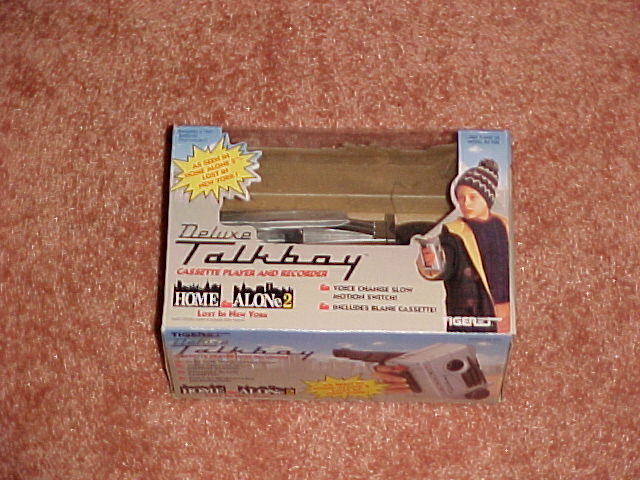

Tuesday, April 26, 2011
Thursday, April 21, 2011
What I did with my tax return
MIAP Program Offers New Summer Course on Copyright and Intellectual Property

Copyright Law for Cultural Institutions 3 credits, July 25 August 5 2011, M-F 9am-12pm (plus an additional hour of online activities each day)
Instructor: Rina Pantalony
This graduate-level course addresses the intellectual property issues and related ethical ones that surround the management, preservation, and dissemination of cultural material (such as paper records and their digital surrogates, museum objects, film, video, and other ephemera) in collecting institutions. The course is designed for current students and also for professionals who already work with cultural objects, providing either a refresher or an upgrade to existing knowledge and practice.
The first step in the registration process is to reserve a space in the course. You can do this by contacting the MIAP Coordinator, Alicia Kubes at tisch.preservation@nyu.edu or 212-998-1618 . After this step is complete, NYU students will be able to register through Albert. All other students will get instructions from the MIAP Coordinator by e-mail.
Any questions about the course or the registration process should be addressed to the MIAP coordinator.
Full Course Description:
With the advent of new technologies, content producers, aggregators and those who manage collections and related ephemera are faced with a number of legal and ethical issues concerning the use of their own works, those of others and in providing access to collections of such works to their patrons and other third parties. Because of the complexity of intellectual property rights, the answers to many such legal questions are not always apparent. Managers of collections are often faced with the need for a risk assessment that takes into account ethical considerations in order to allow a project to move forward.
What are the various legal rights that may encumber cultural material? Who holds these rights? How may they be cleared? What are the extraneous issues that must be given consideration in clearing them? How do these rights affect the subsequent long term exhibition, distribution and hosting of the works once they enter into the collection of a museum or archive? How can these issues be managed effectively? What are the international considerations in dealing with content, created in one jurisdiction, but exhibited or distributed in another? What are the legal considerations in such circumstances and what may be the cultural or ethical considerations?
The issues discussed in this course are the subject of a publication, by the World Intellectual Property Organization (WIPO), authored by the instructor, Rina Elster Pantalony, where the publication will serve as one of the primary texts for the course.
Students will be required to analyze existing collections, examine the intellectual property issues, present findings within existing standards of practice in the field, and use electronic means of communication to compare and contrast findings. All students will be required to participate in assessing risk, preparing intellectual property assessments and discussing their analysis of existing content by posting their findings to a Wiki exclusively developed for the course and hosted by NYU.
The total cost for this 3-credit course including tuition and fees is $3490
Edge of the Wedge
"In Watermelon Sugar the Deeds Were Done and Done Again as My Life is Done in Watermelon Sugar."
The Wedge
Severed Heads
Edge of the Wedge Theorem
In Watermelon Sugar
Wednesday, April 20, 2011
Dreamweapon: The Art and Life of Angus MacLise (1938 – 1979) at Boo-Hooray




The exhibition website states:
On Summer Solstice 1979, MacLise died from hypoglycemia in Kathmandu, and was cremated in the fashion of Tibetan Buddhist funerary rites.
A suitcase of Angus MacLise’s artwork, publications, and manuscript as well as more than 100 hours of recorded music was left with La Monte Young and Marian Zazeela for safe-keeping thirty years ago. This extraordinary time-vault is the foundation of the exhibition, with additional materials drawn from private previously unseen collections and archives.
The 521 West 23rd Street exhibition features manuscript, calligraphy, ephemera, photography, artwork, memorabilia, posters and handbills illuminating MacLise’s multi-faceted career through a narrative of original artifacts.
The 265 Canal Street Suite 601 sound installation, the premiere exhibition at Boo-Hooray’s new Chinatown space, features previously unheard recordings from the 1960’s and 1970’s featuring Angus MacLise performing alongside notables such as: Tony Conrad, La Monte Young, John Cale, Billy Name, Terry Riley, William Breeze, Piero Heliczer, Jack Smith, Lou Reed, Sterling Morrison and Maureen Tucker among others. Each day one may experience a unique set of curated programs of MacLise’s music. Every day is different.
Thursday, May 12th, 2011 at 8pm, Anthology Film Archives are hosting an evening of film and video works by Ira Cohen and Piero Heliczer. At the center is the underground classic, The Invasion of Thunderbolt Pagoda (Dir. Ira Cohen, 1968), showcasing the music of Angus MacLise. The program will also include works by Heliczer featuring MacLise, and Marty Topp's portapak video from the Ira Cohen Jefferson St. loft (1971-72). Boo-Hooray are also pumped to announce the world premiere of Heavy Canon, directed by Ira Cohen (1968/2011). This film is comprised of unseen 16mm footage shot in Cohen’s Mylar Chamber and scored with the music of Angus MacLise.
“Angus MacLise was the Velvet Underground's first drummer. He withdrew when he found out that at a paying job he had to start and stop playing when told to. No one told Angus to stop playing. So the job of a working musician was impossible for Angus, and he taught us all a lesson about purity of spirit.” -- Lou Reed
Co-curator Johan Kugelberg describes Angus MacLise as the American Henri Michaux:
MacLise was a collaborative partner in the early 1960’s with art groups and individuals such as Fluxus (George Maciunas, Yoko Ono), Theatre of the Ridiculous, and Jack Smith. As a poet, MacLise began publishing in partnership with high school friend Piero Heliczer in the late 1950’s, establishing the Dead Language Press in Paris, widely acknowledged as one a most significant small artist book presses of the 20th Century. Together with his wife, artist and underground press illustrator Hetty MacLise, he edited issue No. 9 of the magazine-in-a-box, Aspen, considered a hallmark of American publishing.
Monday, April 11, 2011
La Brune et Moi
Filmed in 1979, screened once in 1980 to a small crowd on the Left Bank, and lost until 2005, I'm sad to say that my 2011 tastes were underwhelmed with this one.
French director Philippe Puicouyoul lifted the story line (Business man falls for a young girl and vows to fulfill her dream of becoming a punk rock star) from Frank Tashlin's (also crappy) 50's Rocker flick, The Girl Can't Help It (1956) for this dumb 1980 "feature", which pieces together a lot of justly forgotten French new-wave musicians. Pierre Clementi, best known as Catherine Deneuve's lover in Belle de Jour, provides some amusement as the business manager of punk manque Anoushka, but the movie fell solidly into the "Rot" category. At least it was short!
The Bands:
Ici Paris
Artefact
Astroflash
Edith Nylon
The Questions (really known as Les Lous)
The Party
Marquis de Sade
Dogs
Go-Go Pigalles
Taxi Girl
Les Prives
Aluminum Music at the Kitchen's 40th

In celebration of their 40th Anniversary, The Kitchen is hosting a party that will be based on a memorable bday-bash-cum-fundraiser in June of 1981 at a Times Square Megaclub. "Dubbed Aluminum Nights, the marathon event saw a capacity audience of many hundreds — including, all seem to recall, Mick Jagger backstage — enjoy a diversified array of the downtown sounds being nurtured at the crossroads of The Kitchen’s music program. In 2011, as part of its 40th anniversary season, The Kitchen presents a distilled refraction of the Aluminum Music performed over that memorable weekend." Site
The Vasulka archive has a pdf of the original event here, which is pretty impressive.
The 2011 'Aluminum Music' event is described on the website:
On Friday, April 15, Industrial music pioneer Z’EV demonstrates his hypnotic, ritualized solo percussion music on a shared bill with cherished No-Wavers, Bush Tetras. Saturday, April 16, features the pairing of former Kitchen Music Director (and Aluminum Nights co-curator) George Lewis’s electroacoustic anthem Homage to Charles Parker (1979) featuring Amina Claudine Myers (piano/organ), Reggie Nicholson (percussion), Matana Roberts (alto saxophone), and Richard Teitelbaum (synthesizers) with the epic disco-minimalism of PeterGordon’s Love of Life Orchestra, featuring contributions from Kitchen alums Ned Sublette (guitar) and Peter Zummo (trombone).
I'm confused about this program for a couple of reasons. The concept of "re-doing" a party from 1981 odd enough, but then quickly just becomes depressing. Especially because most of the artists I would want to see are not participating (compare the 4 page list on the Vasulka's website to the description above). But also, some of these artists might suck really bad now. I love Bush Tetras, but I mostly like them for their musical and visual aesthetic--two things that can not ever be reproduced. So, it becomes sort of... nostalgic and banal. I'm going to give this a fair shot, but this has really never bode well for me in the past. And then you run the risk of remembering a less than perfect version of what is being re-hashed. Case in point: Wire. I saw them a few years ago when my friends opened up for them at Irving Plaza, and it was terrible. I can barely listen to them now. This is really no different. Of course there are exceptions like The Clean or The Raincoats.. and I'm not saying I wouldn't go nuts for a Velvet Underground reunion.. but generally speaking, it doesn't end well.
Also: wasn't the spirit of the original 'Aluminum Music' party contemporary artists and musicians, which attracted the glitterati A-list celebs? What will this show attract? I understand to convey a sense of authenticity, it might be confusing to add young bands or artists, but it just seems really contradictory. I love the Kitchen, and think Nick Hallett is brilliant, but sort of confused about this one.
Friday, April 8, 2011
EAI in Times Square! MTV 44 1/2 , EAI, and The Times Square Alliance Partners to Celebrate Video

This is so exciting! Instead of pontificating as usual, I think it's best to simply re-post the info from EAI's website. Video documentation to follow!
Electronic Arts Intermix (EAI) celebrates its 40th anniversary with a special project for Times Square. In partnership with the Times Square Alliance and MTV, EAI brings artists' visions to the MTV 44½ LED Screen. Marking EAI's 40 years of support for moving image art, EAI in Times Square celebrates video art's rich history of creative intervention in one of the world's most dynamic media landscapes.
EAI partners with the Times Square Alliance and MTV to present artists' video in the astonishing visual landscape of Times Square. From April 13 to 19, EAI will highlight the remarkable creative media interventions of artists on a spectacular scale. Works by Vito Acconci, Dan Asher, Phyllis Baldino, Dara Birnbaum, Gary Hill, Shigeko Kubota, Takeshi Murata, Nam June Paik, Martha Rosler, Stuart Sherman and William Wegman will be seen daily on MTV 44½'s large-format LED screen.
Drawn from EAI's archive, one of the world's leading resources for media art, the videos will play at the top of each hour, between noon and 4pm and between 6pm and 11pm. On Saturday, April 16 and Sunday, April 17 the complete program (25:16 min) will also play at noon.
Spanning the 1960s to 2011, the works range from bold animations and visual poems to witty performances and vibrant electronic experiments. Nam June Paik's rarely seen Hand and Face (1961) is one of his earliest media works; Dara Birnbaum's 30-second Artbreak was commissioned for broadcast by MTV in 1987. Shigeko Kubota brings a profusion of electronic cherry blossoms to the heart of Times Square, while Martha Rosler eyes domestic labor in a suburban backyard. William Wegman's dogs perform a timeless duet.
Each day's program will begin with Takeshi Murata's EAI 40th Anniversary Intro (2011). Linking video art's history to the digital present, this piece was specially commissioned by EAI for its 40th Anniversary programming. Murata's video can also be viewed online here.
Much as early video artists sought to "slow down" television and "talk back" to the media, these creative interjections will challenge viewers to reconsider their visual expectations of Times Square and experience it in new ways. Encountered on MTV's large-scale LED screen, these visions will engage the public not just as consumers, but also as active viewers.
Program Schedule
Noon Takeshi Murata, EAI 40th Anniversary Intro (2011, 1:05 min)
1 pm Shigeko Kubota, Rock Video: Cherry Blossom (1986, 3 min)
2 pm William Wegman, Dog Duet (1975, 2:37 min)
3 pm Martha Rosler, Backyard Economy I (1974, 3:20 min)
4 pm Stuart Sherman, Chess (1982, 30 sec)
6 pm Dara Birnbaum, Artbreak, MTV Networks, Inc. (1987, 30 sec)
7 pm Vito Acconci, Three Frame Studies: Push (1969-1970, 2:59 min)
8 pm Nam June Paik, Hand and Face (1961, 1:25 min)
9 pm Phyllis Baldino, Suitcase/Not Suitcase (1993, 36 sec)
10 pm Gary Hill, Objects With Destinations (1979, 3:41 min)
11 pm Dan Asher, Artificial Illuminations: Calligraphic (1997, 55 sec)
EAI in Times Square is part of an ongoing series of events and projects marking EAI's 40th anniversary year. For more information about upcoming and past programs in this series, please click here.
About the Times Square Alliance
Times Square Arts presents temporary cutting-edge art and performances in multiple forms and media to the 360,000 to 500,000 daily visitors to New York City's Times Square, making it one of the highest profile public arts programs in the United States. Since its inception three years ago, Times Square Arts has featured works by a diverse group of more than four dozen prominent and emerging artists. The Times Square Public Art Program is made possible in part by the NYC Cultural Innovation Fund of the Rockefeller Foundation, Rockefeller Brothers Fund and the NYC Department of Cultural Affairs. www.TimesSquareNYC.org/arts
About MTV 44½
A standout among the large electronic displays in Times Square, MTV 44½ captures the eyes of viewers with unique programming, live tapings, special events, concerts, and MTV-branded creative that breaks through the clutter in Times Square. www.mtv445.com
EAI: Celebrating 40 Years
Founded in 1971, Electronic Arts Intermix (EAI) is one of the world's leading nonprofit resources for video art. A pioneering advocate for media art and artists, EAI fosters the creation, exhibition, distribution and preservation of video art and digital art. EAI's core program is the distribution and preservation of a major collection of over 3,500 new and historical media works by artists. EAI's activities include viewing access, educational services, extensive online resources, and public programs such as artists' talks, exhibitions and panels. The Online Catalogue is a comprehensive resource on the artists and works in the EAI collection, and also features extensive materials on exhibiting, collecting and preserving media art: www.eai.org
Electronic Arts Intermix 535 West 22nd Street, 5th Floor New York, NY 10011
info@eai.org t (212) 337-0680 f (212) 337-0679
This project was made possible by the generosity and support of MTV 44½. The Times Square Alliance and EAI thank MTV 44½ for their ongoing support of the arts.



Lucy Lippard lecture at SVA
The Art Criticism and Writing MFA program at SVA sponsored the brilliant curator, "critic", writer, and activist Lucy Lippard last evening. The talk, titled "Ghosts, the Daily News, and Prophecy: Critical Landscape Photography" examined the role and effectiveness of photography in generating responsibility for place. Much of the lecture was extracted from her most recent project "The Lure of the Local: Senses of Place in a Multicentered Society." The Manhattan native moved to New Mexico a few years ago, and is active with city planning and watershed restoration. Always an activist, it comes as no surprise that Lippard is heavy into land use issues, and artworks as activism.
I am still processing the pithy lecture, but I expect that it will be made public soon at this website. (the other lectures in the series are here as well.)
Very interesting to me was that her talk made no argument, nor did it actually 'critique' any art work. It was more a presentation of landscape photographs which illustrated a discussion about local and global power relations, the role of art, and the deconstruction and de-contextualization of visual knowledge. Early on in the talk, she disclaimed the distinction between being a critic and an advocate of art. She identified with the latter, but accepted the former. She flat-out rejected being a theorist. To Lippard, being a theorist marks a sort of hardening of the veins. A very even-keeled, approachable, scholar, I am happy to report how refreshingly human she was, for such a prolific genius.

Dara Birnbaum at EAI

Marking the occasion of a new comprehensive catalog and retrospective on the prolific ouevre of Dara Birnbaum, a selection of the artist's early performance-videos were screened at Electronic Arts Intermix on March 30th. Editors of the new publication, Karen Kelly and Barbara Schröder introduced these early black-and-white, performance-based videos, which preceded her single channel works. Unlike the later works, which appropriated and critiqued mass media and TV culture, these direct, unmediated, and tautological performance-based works shed new insight by introducing themes recurring throughout her later work.
"In many of these works, Birnbaum appears on camera as the performer, investigating through the body intense emotional or psychological manifestations while also foregrounding the relation of the camera/viewer to the subject/performer. Such works reveal an unexpected link to the body-art and performance-video practices of artists such as Vito Acconci, Joan Jonas, and Bruce Nauman. Other early works incorporate disjunctive tactics and pop-cultural content, pointing to Birnbaum's later editing strategies and engagement with television as source material." (EAI program notes)
Following the screening, Birnbaum appeared in conversation with Lori Zippay, Executive Director of EAI, and participated in discussion with the audience.
 I found Dara's citation of Vito Acconci's influence in the 1970s fascinating. Having never seen these early videos, I wouldn't necessarily have anticipated this parallel, although given their common interest in Architecture, the epistemologies of video space, and camera-viewer-performer dynamics, it makes sense. I would have expected a much stronger bond with say, Joan Jonas, who Birnbaum cited only after an audience member asked about her connection to pioneers in feminist video. She also cited early influence by Bruce Nauman and Dan Graham. (The latter whom she co-wrote a text on video/architecture in the early 80s if I'm not mistaken.) As well as the theoretical writings of Jacques Lacan, of course.
I found Dara's citation of Vito Acconci's influence in the 1970s fascinating. Having never seen these early videos, I wouldn't necessarily have anticipated this parallel, although given their common interest in Architecture, the epistemologies of video space, and camera-viewer-performer dynamics, it makes sense. I would have expected a much stronger bond with say, Joan Jonas, who Birnbaum cited only after an audience member asked about her connection to pioneers in feminist video. She also cited early influence by Bruce Nauman and Dan Graham. (The latter whom she co-wrote a text on video/architecture in the early 80s if I'm not mistaken.) As well as the theoretical writings of Jacques Lacan, of course.The question that resonated most with me was from EAI's Josh Kline, who asked the artist how she had conceptualized and weighed her role as a director in these early works. Since these works rest on a combination of the technical parameters of the cameras and the concept, he wondered to what extent she had directed the various players. Surprisingly, she admitted very little responsibility, saying that it was mostly a collaborative effort with her making aesthetic decisions.
Ladies Birnbaum and Zippay will also be in conversation at White Columns April 14th for the Second installment of the Skowhegan Conversations Series, (an ongoing series of collaborative dialogs between Skowhegan and White Columns)
The retrospective that was the impetus for the new catalog, is being exhibited at S.M.A.K., Ghent, in 2009 and Museu Serralves, Porto, in 2010. Hopefully after those two venues, it will come to New York!
Friday, April 1, 2011
Bits of Broodthaers

Delving into a post about Broodthaers is out of the question here, because I generally don't spend more than a few minutes on posts. And there is SO much to say about the prolific artist.
I found this image of his tombstone, that he designed, and wanted to post it. Broodthaers died in Cologne on his 52nd birthday. He is buried at Ixelles Cemetery in Bussels.
Wednesday, March 30, 2011
Dance Capsules: Walker Art Center acquires Merce Cunningham Dance Company Collection

Robert Rauschenberg, set piece for "Minutiae," 1954.
Photo by Herb Migdall, 1976.
Courtesy Cunningham Dance Foundation.
| Minneapolis. I think I might be able to do it. I could live there if I could work or study at the Walker, with their AMAZING collection to keep me intellectually stimulated. That city isn't bad, from what I recall. This comprehensive acquisition of the Merce Cunningham Dance Company's collection only makes it that much more appealing. E-flux writes: The Walker Art Center and Cunningham Dance Foundation (CDF) announce the Walker's acquisition of a comprehensive collection of artist-made set pieces, costumes, painted drops, and props, created for the internationally renowned Merce Cunningham Dance Company (MCDC). Over the course of his nearly 70-year career, Merce Cunningham (1919–2009) redefined the visual and performing arts through pioneering collaborations with leading artists, designers, and musicians. More than 150 objects created by such artists as Robert Rauschenberg, Jasper Johns, Andy Warhol, John Cage, and Frank Stella will arrive at the Walker this year and be displayed for the first time beginning in November 2011. The placement of these works at the Walker supports a key goal of CDF's Legacy Plan—ensuring the preservation and ongoing accessibility of the Company's singular collection of 20th century art. The acquisition of major works from the MCDC collection aligns with the Walker's cross-disciplinary collecting strategy and its mission to present contemporary art in a multidisciplinary context, in order to foster an understanding of the nexus between artistic disciplines. The acquisition marks a major landmark in both the museum and dance fields, making the Walker a new center for research and scholarship of Cunningham's work, and presenting a new model for preserving works created by multiple artists in support of a single choreographer's artistic vision. "The acquisition of these works is groundbreaking for the Walker and for the museum field at large, affirming our longstanding commitment to bringing together diverse artistic practices to form a cross-disciplinary blend of programs," said Walker Executive Director Olga Viso. "We enjoyed a lasting relationship with Cunningham beginning in the early 1960s and look forward to inspiring future generations with programs, exhibitions, and new scholarship devoted to his legacy of innovation and collaboration." The Walker will present its first installation of works from the collection in November 2011, in an exhibition focusing on Cunningham's creative collaborations with major artists. This exhibition coincides with MCDC's final engagement at the Walker, to be presented November 4–6, 2011, as part of the Company's farewell Legacy Tour. The engagement continues a relationship that began in 1963, when MCDC was first presented by the Walker. The performances will be the company's first actually held inside the Walker (all past MCDC performances have been off-site or outdoors).The Walker will organize additional exhibitions exploring Cunningham's collaborations with artists over the next three years. The Walker is acquiring more than 150 objects dating back to 1942, when Cunningham began his distinguished 67-year career. During that time, Cunningham choreographed nearly 200 dances, most of which involved significant collaborations with leading visual artists who contributed unique set pieces and costumes. Notably, the collection contains Robert Rauschenberg's combine Minutiae (1954/1976) and his costumes for Antic Meet (1958), Frank Stella's set pieces for Scramble (1967), and the mylar pillows from Andy Warhol's Silver Clouds installation used for RainForest (1968), and works created independently by John Cage, Cunningham's life partner, that were ultimately incorporated into MCDC dances. The collection also includes set pieces and costumes created in the Company's later years by a younger generation of artists, including Ernesto Neto and the fashion designer Rei Kawakubo. To complement the acquisition and aid in ongoing scholarship, CDF will grant the Walker access to "Dance Capsules"—digital packages of archival materials which are being developed as another part of the Legacy Plan. Each Dance Capsule contains documentation of a Cunningham work, including performance videos, sound recordings, lighting plots, décor images, costume design, Merce Cunningham's choreographic notes, production notes, and interviews with dancers, and will serve as an invaluable supporting resource for Walker programming and the public. The acquisition is a gift of Jay F. Ecklund, the Barnett and Annalee Newman Foundation, Agnes Gund, Russell Cowles and Josine Peters, the Hayes Fund of HRK Foundation, Marion Stroud Swingle, Kathleen Fluegel, Barbara G. Pine, and the T. B. Walker Acquisition Fund, 2011. |
Tuesday, March 29, 2011
Janet. and her uncanny obsession with her breasts

The image found in the liner notes for "Janet." album, was a cropped version of the photograph above, which also appeared on the cover of Rolling Stone magazine. The pic, shot by Patrick Demarchelier, featured a relaxed and confident Janet whose bare breasts were being held by her husband (at the time) René Elizondo, Jr.

After "Janet." came "Poetic Justice," her filmic debut, which was panned. This didn't make one bit of difference to me as a 10 year old, renting the VHS from Blockbuster. I thought it was cinematic gold, and held it over all my friends that they weren't allowed to rent it. Plus there's this:
 Amid the media hurricane that came along with defending Michael from child molestation alligations, as well as denying Latoya's public claims that the Jackson parents abused their children, mixed with her own high profile success; Janet started getting a little weird... and really into her boobs.
Amid the media hurricane that came along with defending Michael from child molestation alligations, as well as denying Latoya's public claims that the Jackson parents abused their children, mixed with her own high profile success; Janet started getting a little weird... and really into her boobs.
She also thought it would be a good idea to be in the sequel to the Nutty Professor remake?


Hey, check out my boobs!

The peak of all this funny business was undoubtedly at the 2004 Superbowl halftime, where the Janet performed with Justin Timberlake, who tore half of her bra off exposing her left breast. The two performers both apologized, claiming it was a "Wardrobe Malfunction." The photos evoke an original sin connotation, with Janet looking shamed and irresponsible, while J-Tim looks guilty and unapologetic.
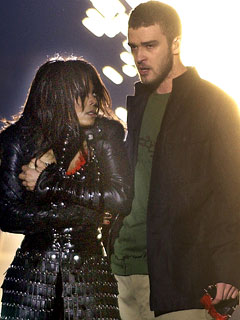 "What does this mean for boobs?" you might ask. From Lil Kim, to U.S. Attorney General John Ashcroft, to Janet Jackson the United States is oddly conservative regarding breasts, which only further fetishizes them within our cultural fabric, and results in a tightening of FCC regulations. It's ironic, given the overwhelming support of breast cancer/ (I prefer the term "breast health") awareness in this country. Culturally, America needs to turn this fear-respect relationship to breasts into a love-respect relationship. Now I'm really ranting, this was supposed to be a funny slide show, and has now turned into an (probably) ill-informed cultural proscription. I'm sure some scholar somewhere has theorized about this in a more coherent manner.
"What does this mean for boobs?" you might ask. From Lil Kim, to U.S. Attorney General John Ashcroft, to Janet Jackson the United States is oddly conservative regarding breasts, which only further fetishizes them within our cultural fabric, and results in a tightening of FCC regulations. It's ironic, given the overwhelming support of breast cancer/ (I prefer the term "breast health") awareness in this country. Culturally, America needs to turn this fear-respect relationship to breasts into a love-respect relationship. Now I'm really ranting, this was supposed to be a funny slide show, and has now turned into an (probably) ill-informed cultural proscription. I'm sure some scholar somewhere has theorized about this in a more coherent manner.One thing about Janet is that she never stays out of the public eye for too long, so it probably won't be long now before she resurfaces, boobs waving in the spotlight.








